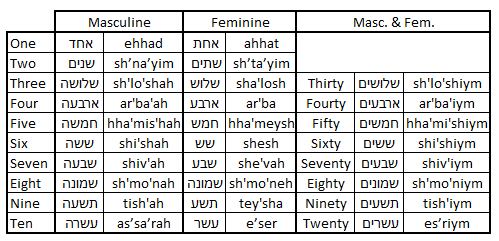Hebrew
Shalom everyone: “Ma nishma?” This week in Lesson 12, we going to learn how to ask about prices: “How much something cost.” We are at Week 12 and Lesson 12 — “How Much Does it Cost?”
Please, note the following: If you have trouble viewing the page, select another way to view it i.e. tablet view, or phone view vs the large desktop view.
-
McDonald’s at The Dizengoff Center Mall in Tel Aviv
Lesson Synopsis & Overview
Within this lesson of Hebrew and vocabulary, we are learning how to ask the price of something, we are learning more numbers, and we are learning how to ask someone’s age all while we visit some shops. This is Lesson 12: “How Much Does It Cost, Prices, Clothes, and More Numbers“.
Table 1: Other Nikkud

Table 2: Ivrit Alef-Bet
Vocabulary Clothes [0:23]
-
- seamlah: dress (sihn+mem+lamed+hei) [0:25]
- holtzah: shirt (cheit+lamed+tsade+hei)
- na’al: sneaker (nun+ayin+lamed)
- na’ali‘im: (2)shoes (nun+ayin+lamed+yod+mem_sofit) [[im] =2] [0:40]
- mic’nasi’im: (2)pants (mem+kaf+nun+samech+yod +mem_sofit)
- kovah: hat (kaf+vav+vet+ayin) [0:56]
- mae’el: jacket (mem+ayin+yod+lamed) [1:03]
-
Vocabulary Numbers [1:09]
-
NOTE: To review numbers, refer to lesson 10 part one. Also, numbers have genders- masculine and feminine
[1:16 ]Numbers 13-19– How to: combine 10 with the unit digits for teens. Example–sh’lo’shAH is 3 + 10 = eser (m); or sholosh-esrah (f) BE MINDFUL OF THE GENDER [(#) +10] which becomes 13;
- adding eser (ayin+sihn+resh) or esrah (ayin+sihn+resh+hei)
- for males eser (ayin & sihn nikud is a kametz- gives the “ah” sound
- for females esrah (here the ayin nikud is segal – gives the “ee” sound)
- 14 = arba – esrah (f) [1:34]
- 14 = arba-ah – eser (m) [1:38]
- 13 = sha’losh – esrah (f) (shin+lamed+vav+shin)
- 17 = she’vah – esrah (f) (shin+vet+ayin)
- 19 = tay’shaa – esrah (f) (tav+shin+ayin) sounded like “chi” [1:48]
- adding eser (ayin+sihn+resh) or esrah (ayin+sihn+resh+hei)
-
Tens 10, 20, 30…. Hundreds 100, 200 same for male and female
- 20 = esrim (ayin+sihn+resh+yod+mem_sofit) [1:59]
- 30 = sh’lo’shim brother (shin+lamed+vav+shin + yod+mem_sofit) [2:01]
- 40 = ar’ba-im (alef +resh + bet + ayin + yod + mem_sofit) [2:03]
- 50 = (c)ha’me’shim (cheit + mem + shin + yod + mem_sofit) [2:06]
- 60 = she’shim (shin + shin + yod + mem_sofit) [2:09]
- 70 = sheev’im (shin + vet +hey+yod + mem_sofit) [2:12]
- 80 = shi’mo’nim (shin + mem + vav + nun + yod + mem_sofit) [2:16]
- 90 = tish’im (tav + shin + ayin + yod + mem_sofit) [2:19]
- 100 = ma’ah (mem + alef + hei) [2:21]
- 200 = ma’ taim (mem +alef +tav + yod + mem_sofit) [2:25]
- 53 people = hameshim- v’ shalosha anashim [2:32]
- 148 shops = ma’ah arbaim- v’ shmonah (c)honu’ot ([2:40]
-
Vav Pronunciations Discussed: Changes with the sound that follows its use
- Vav = ooh or vah or vee; However, most say “vey” [2:51-3:09]
-
Asking Someone’s Age (Year is Feminine)
- Man’s age = ben kama atah? [3:16] How old are you? (m)
- Ani ben shloshim v’ tashar [3:20] I am 39 years old.
- Woman’s age = bat kama at? [3:26] How old are you? (f)
- Ani bat she’shim v‘ ahat [3:33] I am 61 years old.
- shannah = a year, shnati’im = 2-years, shanim + than 2 years
- Man’s age = ben kama atah? [3:16] How old are you? (m)
Humphrey & Bacall

Laalot= to go up, to climb = also means to cost = ali’ot: from Lesson 9 answer sheet Answers: http://www.dg-global.com/wp-content/u… [4:00] $s to ₪s From dollars to shekels
- kama zey oleh? = How much does it cost? [4:07]
- shekel (m/s)- currency = ₪ symbol; shekelim (m/pl) [4:11]
- prices are masculine = zey oleh shi-shah *shekelim = That cost 6 (m) shekels.
- shekels with number 2-10 = shekelim = used in *plural form only [4:23]
- either shekel/shekelim for numbers above 10 (i.e. 11+) [4:29]
- ex. tishim v’ chammesha shekelim; or
- ex. tishim v’ chammesha shekel
- both = ₪ 95.00 [4:34]
Daniel on Sheinkien Street, Tel Aviv [4:40]
Daniel’s questions to us about the clothes are below at QUESTIONS [4:56]
- Daniel to male shopkeeper: Slicha, kama olah holtzah hazot? [4:46] Excuse me, how much is that shirt?
- Male shopkeeper: ha’holtzah hazot olah ma’tim shloshim shekel. That shirt is 230 shekels. ₪ 230.00 = $ 66.00 approx.
- Daniel to female shopkeeper: kama olah ha’seamlah hazot? How much is that dress? [5:00]
- Female shopkeeper: ha’seamlah olah ma’tim sheshim shekelim. That dress is 260 shekels. ₪ 260.00 = $ 75.00 approx.
- Daniel to female shopkeeper: Slicha, kama oliot ha’na’alim haoleh? [5:26] Excuse me, how much are these shoes?
- Female shopkeeper: hen aliot ma’ah v’ ta’shar – esrah shekelim. Those shoes are (cost) 119.00 shekels. ₪ 119.00 = $ 34.00 approx. [5:28]
- Daniel to female shopkeeper: Slicha, kama oliot ha‘mic’nasi’im haoleh? [5:26] Excuse me, how much are these pants? [5:50]
- Female shopkeeper: Ken? Yes?
- Female shopkeeper: ma’ah sheshim v’ tesher shekelim. The pants cost 169 shekelim. [5:54] ₪ 169.00 = $ 49.00 approx. [5:54]
הסוף the end hsef
Vocabulary and Phrases
- Found within the dialogue
Adjectives-vocabulary
- numbers – found within the dialogue
Vocabulary & Verbs Used Explained
- Only three verb tense – Past, Present, Future
Vocabulary with Dialogue continues:
- none
Comments
- Another short lesson under 7-minutes.
- Advice: Take it slow. And please, use the transliterations I have provided for you. OPEN VIDEO IN NEW WINDOW. If there is something that you do not understand, please, do send me a “message or comment” or email.
- Oh! RE ((c)H) when you see this (c)H or ((c)h) it is to show you that this sound is “guttural” no English equivalent, however, listen out for the sound and just practice.
- Note: Question and Answer Worksheets are below: The Closing.
Questions
- [4:56] Shirt
- Q: kama olah ha’holtzah ? How much is the shirt? How much does the shirt cost?
- A: ha’holtzah hazot olah ma’tim V’ shloshim shekelim or shekel. That shirt cost 230 shekels. ₪ 230.00 = $66.00 approx.
- [5:15] Dress
- Q: kama olah ha’seamlah ? How much is the dress?
- A: ha’seamlah olah ma’tim V’ sheshim shekelim. That dress cost 260 shekels. ₪ 260.00 = $74.00 approx.
- [5:36] Shoes
- Q: kama olot h’nal -li-im ? How much are those shoes?
- A: h’nal -li-im olot ma’ah v’ ta’shar – esrah shekelim. Those shoes cost 119.00 shekels ₪ 260.00 = $34.00 approx.
- [6:00] Pants
- Q: kama olim ha‘mic’nasi’im? How much are these pants?
- A: ha‘mic’nasi’im olim ma’ah sheshim v’teshar shekelim. These pants cost 169 shekels. ₪ 169.00 = $49.00 approx.
- [6:14] Conclusion how old is… more apparel
- Q: ben kama atah? How old are you (m)?
- A: ani ben atah arbah – eser (m) I am 14 y/o
- Q: bat kama at? How old are you (f)?
- A: ani bat kama shlosh – esrah (f) I am 13 y/o
- Q: kama oleh h’kover h’zeh? How much is this hat?
- A: zeh kover shesh shekelim. This hat is 6 shekels ₪ 6.00 = $1.70 approx.
Shalom and See you soon! Shalom ve’ l’hitraot!
Review Lesson
Review of the pronouns
“who” for him is “Hem” (masculine plural); “who” for she is “Hen” (feminine plural) , “Gam” = also. “Anachnu” = we. “Atah” you (m-s). “Atem” = they (m/f-pl). You/ They” feminine: You – “At” you (f-s), “Aten” = they (f-pl). The words for “this”, “these.” “Zi, Ze, & Zot”
Use this or any video to return to often whenever you feel the need. Suggestion: Also use the YouTube site w/ Daniel and use the script above to help. Open in a separate window.
Closing Conclusion
In this lesson we learned how to ask and answer questions in shopping. Up Next: Lesson – 13 “What’s the time?”
Learn Hebrew: Lesson 13 – What’s the time – hours and the days of the week
Homework (Practice in Hebrew):
- Exercises: https://goo.gl/D4zu1F
- Answers: https://goo.gl/DFTrjA
Self-test review
Don’t be discouraged, rather be empowered. Namaste.
Find your peace while you study & let’s stay the course. Shalom.
Table 3: Hebrew / Ivrit Numbers

credits
Images by: TimeOut “Israel’s top shopping malls and markets, antiques, and boutiques” from TimeOut. LangEasy “Where to do Shopping in Tel Aviv?” from LangEasy. gifer “Nothing You Can’t Fix” from Gifer.com. Image from alamy stock: “Tel Aviv Dizengoff Centre Shop.” from “alamy.com. “How much does it cost?” Lesson 12 w/ Daniel Gaynor; Recorded May 17, 2018; Image from Ancient-Hebrew: “A History of the Hebrew Word for One.” from “Ancient-Hebrew.org.” Tables from Judaism 101.
Disclaimer
Transliterations vary, there is no right way nor wrong way to interpret a language devised of symbols. English, therefore, tries its best. So, don’t be alarmed by different spellings of Hebrew words being sounded out.
“…and there were dwelling at Jerusalem Jews, devout men, out of every nation under heaven.. Now, when this was noised abroad, the multitude came together, and were confounded, because …Everyman heard it in his own language”(Acts/Gevurot 2: 5-8).
“How much does it cost? Take 2-weeks on this lesson
Blog 227; Volume 6
(c) 2015-2215 crew @ miracle production enterprises, inc.





